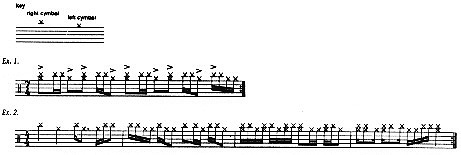Welcome to PaulWertico.com!
Flat Ride Cymbals
Make Mine A Double
Recently, I've had a number of drummers approach me to inquire about my double flat-ride setup. They've wanted to know what type of cymbals they were, what sort of patterns I was playing, and how this setup came about. I'd like to answer those questions and give you some ideas on how to approach double flat ride playing.
The first time I heard a flat ride cymbal I knew I was hooked for life. It was on the classic Chick Corea trio record "Now He Sings, Now He Sobs", (Blue Note) with the great Roy Haynes on drums. On that recording, Roy played a cymbal unlike any I had ever heard. It had an extremely dry "tick" type quality that gave it unbelievable clarity and definition. Yet, when he really laid into it, it almost sounded like breaking glass. It turned out to be a Paiste Formula 602 flat ride. I immediately went out and bought one (even though at that time they were hard to find) and that was it: The flat ride had become part of my sound!
Later, I purchased some different sounding flat rides of various sizes and weights, and started using two, sometimes three, in my setup. When I got the gig with the Pat Metheny Group, the flat ride was already part of the group's sound, since Danny Gottlieb had used them extensively before I joined. So I felt right at home.
The reason flat rides work so well in Pat's group is because of their clarity and definition. They don't cover up the other instruments with any kind of "wash" that would "muddy up" the sound, so it's possible to play very intricate patterns on them even while using a wide range of dynamics. They also allow you to play very intense and busy, while still maintaining a certain lightness. Thus, you can propel the band without becoming over-bearing and getting in the way.
The ones I'm using currently with the Pat Metheny Group are a Paiste 22" Sound Creation Dark Flatride on my right, and the new Paiste Signature Series 22" Flatride (with a Pro-Mark rattler) on my left. Keep in mind, though, that many cymbal manufacturers make flat ride cymbals, each with their own definitive sound. Be sure to test as many as possible before making your purchase, so that you'll find the flat ride sound that is appropriate to your playing style.
The types of patterns I usually play are random patterns based on paradiddle-type sticking, played in reaction to the melody and soloist. I constantly move the sticks in and around the cymbals to bring out various dynamics and tone colors. This gives a consistent "rise and fall" sound and adds a certain three-dimensional quality to the groove. Sometimes I play things that are similar to the two-against-three-type patterns that are played on Brazilian shakers called caxixi. I also bounce back and forth between either flat ride and my snare drum, which is tuned really tight. They complement each other well, and doing this gives the groove more "snap".

Ex. 1 is a typical groove that I might play using double flat rides, with many variations, of course. Ex. 2 is not intended to be used as a groove, but rather as an exercise for you to develop a feel for how the cymbals interact with each other. Try to get the cymbals to open up while still maintaining a crisp stick attack. Play quarter-notes on the hi-hat.
Create and combine your own patterns made up of various single, double, triple, and unison strokes, with the idea of getting your flat rides (and snare) to play off one another. Holding your sticks loosely seems to open up the sound, and remember to move around on the cymbals. This way you can play with complete rhythmic accuracy while still sounding like you're floating. Good luck!
Images and Information from Drums & Drumming February/March 1990, page 65